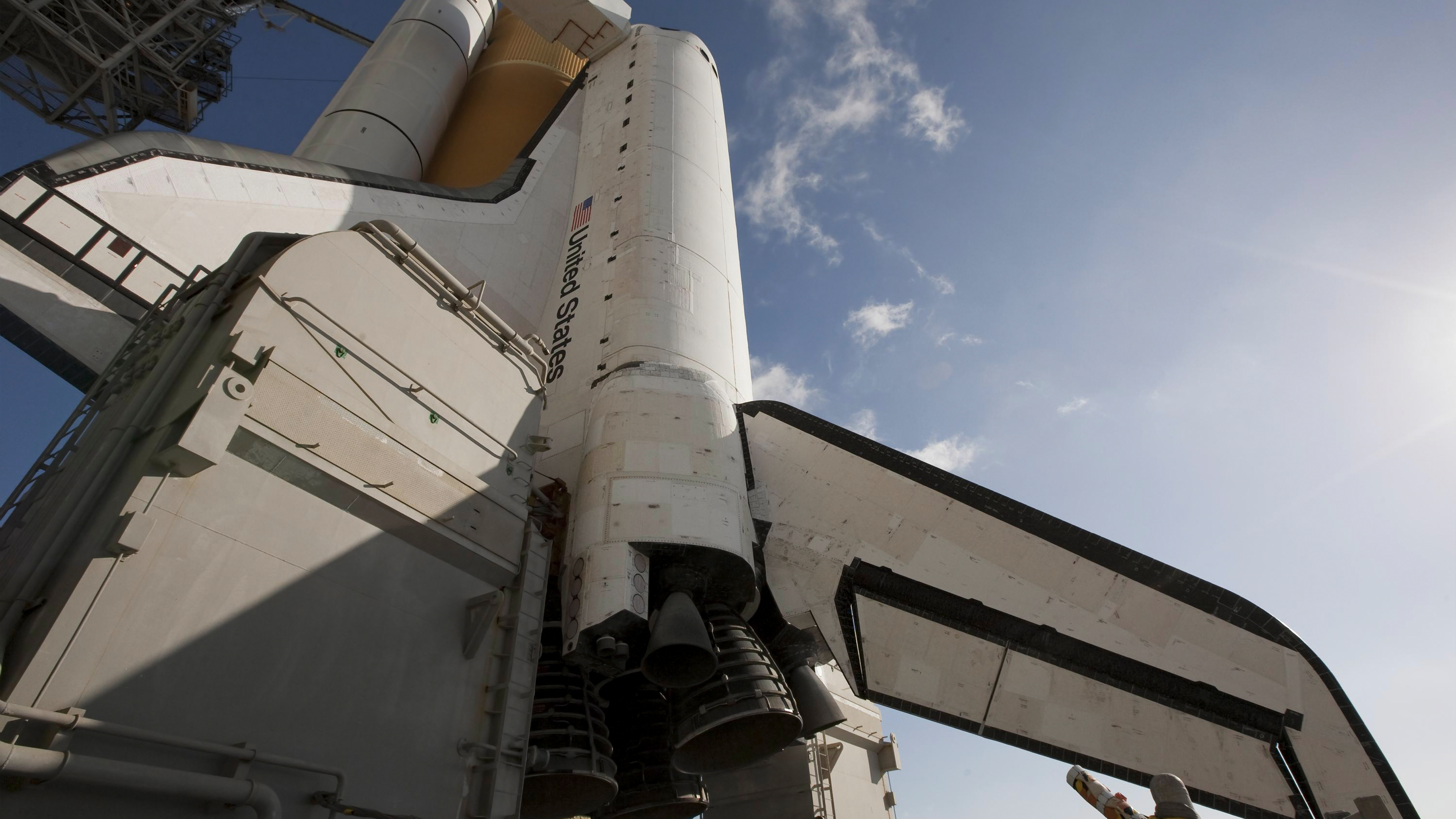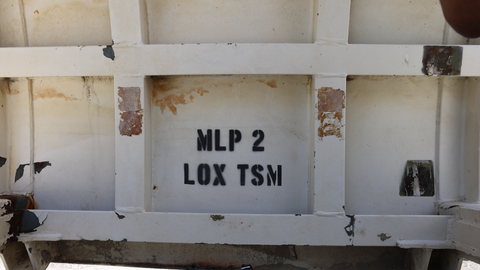
- by Dianna Lopez
MLP-2: Launching NASAs Legacy for 50 Years
- by Dianna Lopez
A question? Visit our contact page
This site uses cookies for better user experience and analytics.

Our newest PlaneTag is more of a SpaceTag, but then again it never left earth. It just happened to be on hand for some of the most historic space launches of the 20th century. In fact, it launched the maiden voyage of every Space Shuttle (except Columbia) and launched several Apollo lunar missions and Skylab. Take a closer look at MLP-2 and find out how MotoArt acquired the material to create NASA MLP-2 PlaneTags.

The Mobile Launcher Platform, or MLP, is a two story structure which was originally built for NASA’s Apollo program to launch Saturn V rockets, and later to support the Space Shuttle stack during the build up and launch stages. The 6 million pound structure could support an additional 12 million pounds during assembly at the Vehicle Assembly Building (VAB), and while being transported to one of the Launch Pads. Once transported, the MLP served as the vehicle’s launch platform.
The Mobile Launcher was developed in 1963 to support NASA’s Apollo program. The aim of Apollo was to land mankind on the moon and return them safely to earth, and was successfully accomplished between 1968 to 1972. A Launch Operations Center (LOC) was developed at Cape Canaveral, Florida (now Cape Kennedy, home of the Kennedy Space Center), which would house Launch Complex 39, a Launch Control Center, and the VAB. The space vehicle (both the launch vehicle and spacecraft) would be assembled in the VAB on one of three Mobile Launchers (later called Mobile Launcher Platforms), then later moved to one of the several launch pads via crawler-transporter.
For the Saturn V launch vehicle, each stage was built by different manufacturers then shipped to the LOC for assembly. They were:
The components were so large that two of them had to be shipped by barge. The S-IVB, the third stage was shipped by barge from California through the Panama Canal because it was too large and heavy to go by rail. That mode of transportation was later replaced by the Super Guppy.
At the VAB, the stages would then be placed horizontally and inspected, then assembled vertically. The Saturn V rockets were assembled this way rather than horizontally because it was felt that horizontal assembly would present too many engineering challenges.
After the Apollo program, the Mobile Launcher was then modified for use with the Space Shuttle. The Shuttle’s components were prepared for launch at the VAB.
The SRBs would be attached to the External Tank, then Orbiter would next be mated to the external tank. This stack would be assembled on the MLP, then transported by crawler-transporter to the launch pad.
Watch this video about the MLP during the Space Shuttle Program.
MLP-2 was the second of three mobile launchers used by these programs. It was used for the following missions:

As Mobile Launcher-2 (ML-2) with the Apollo Program

Redesignated Mobile Launcher Platform-2 (MLP-2) after conversion for use in the Space Shuttle Program
It was announced in January 2021 that NASA would be demolishing MLP-2 due to lack of storage space. Many aerospace enthusiasts, including MotoArt owner Dave Hall, saw the announcement and were intrigued.

Hall was excited about the idea of having a part of such an integral part of the space program but even he was not sure where to start. He enlisted the help of two of the moderators of the fan page MotoArt PlaneTags Collections Paul Davies and Rob Schneider.
“I had seen the article posted, and I couldn't believe my eyes. I had grown up watching launches and following the Shuttle missions on TV. I had been to Cape Canaveral and took the bus tour around the complex. I had literally driven alongside the crawlerway and saw the Shuttle being escorted on an MLP. I could not believe that one of the iconic launch pads was being destroyed forever. What blew my mind even further was the fact that no one had expressed any interest in preserving her, not even the Smithsonian Museum.” - Paul Davies
Watch Dave, Paul, and Rob discuss over Zoom how they acquired the TSM from MLP-2.
Once they accessed MLP-2, the trio combed the structure to find the right material for what they envisioned.
“The first thing we noticed was how thick everything was. The door was ¾” steel. Everything was so unbelievably heavy. Once inside, it felt like we were walking around a bunker. Pipes, wires, access doors and electrical panels were everywhere… We kept saying, though, that all of those thin pieces just didn’t have any wow factor. We needed something from up top, something that would have been exposed to the launches themselves.” - Rob Schneider


On the MLP-2, there were two large devices which sat to either side of the main engine exhaust hole. The TSM provided umbilical connections to the orbiter - one side held a liquid-oxygen line and the other a liquid-hydrogen line - which fed the propellants from the launch pad tanks to the external tank. Other umbilicals carried helium, nitrogen, ground cooling, purge air, electrical power and comm links. The umbilicals retracted into the masts at launch and were protected from flames by protective hoods.

They were 15 feet long, 9 feet wide, and rose 31 feet above the MLP deck. They also housed six hydrogen burnoff pre-igniters, which were activated right before main engine ignition to ignite any free hydrogen that might cause rough combustion at the engine start.
“We started poking our heads into the TSM’s and measuring thicknesses of all the surfaces with our tape measures. As we were standing inside the TSM, we all came to the realization that the fuel lines laying on the ground, and the housing that we were inside was the last thing to touch Challenger. It became hallowed ground, and we were humbled by our surroundings. We knew that the TSM was what we had to make tags out of. We debated about how to make the trap doors work, measured the thicknesses of the blast doors, and the walls. Everything was thick, but we knew that we had found our material.” - Paul Davies

The material from the TSMs had to be cut down then shipped to Mojave for handling. Once those logistical challenges were over, there were new ones to overcome. The manufacturing process for these special PlaneTags was unlike any other one before it. “We thought we had a devil of a time with our SR-71 and L-1011 PlaneTags, but this was far beyond anything we had ever worked with before,” said Hall.




The team was used to working with aluminum, not ½ inch thick hardened steel. They could not be cut or lasered in the usual manner with the equipment used in most other PlaneTag manufacturing. A new process had to be worked out to cut out the thick pieces and etch them. The packaging was also a challenge. Paper could not support such a heavy PlaneTag, so the team came up with the idea of creating a display card from aluminum.






Although the MLP-2 never left the earth, the newest PlaneTags are truly out of this world. This special edition PlaneTag will be numbered to 20,000. They are individually cut, polished and etched, then attached to an aluminum display card with a strong earth magnet. Although they can’t be used as a luggage tag or custom engraved, they are a beautiful memento of the United States’ space program of the 20th century and will make an incredible, one-of-a-kind collectible for any NASA or aerospace collector.


From Warbird to Water Bomber: The Epic Life of the Hawaii Mars
In the world of aviation, few aircraft have lived a life as large, or as long, as the Hawaii Mars. Towering over most of its contemporaries with a wingspan of 200 feet, this mighty flying boat was born in the final days of World War II, then quietly transformed into one of the most iconic aerial firefighting aircraft the world has ever seen. From military transport to firefighting titan, the Hawaii Mars represents one of aviation’s most extraordinary second acts.
In 2025, MotoArt obtained an original wing of this aircraft and created special PlaneTags, made exclusively for the Martin family members and Mars workers. On December 11, 2025, Hawaii Mars PlaneTags will be available to the general public for the first time.
F-14 Tomcat Coasters: A Legendary Fighter Reimagined for Your Home
Few aircraft define an era quite like the Grumman F-14 Tomcat. Sleek, powerful, and unmistakably iconic, the Tomcat was the Navy’s premier fleet defense fighter for more than three decades. From Cold War missions to pop culture stardom, the F-14 remains one of the most recognizable and beloved aircraft ever built. Today, MotoArt is proud to introduce the F-14 Tomcat Coaster Set, created from authentic F-14 aircraft material.
PR-AJB: The Story of an Azul Airbus A320 With a Global Journey
Every airplane has a story, and some travel farther than others before their flying days are over. PR-AJB was one of those well-traveled aircraft. This Airbus A320 started its life flying British families on long-awaited holidays, then later crossed the Atlantic to join the growing fleet of Azul Linhas Aéreas Brasileiras. Over nearly nineteen years it picked up new registrations, new paint, new routes and a new home, carrying thousands of passengers along the way.
Its journey reflects how widely the A320 family has spread around the world and how easily these aircraft adapt to whatever their next chapter requires. PR-AJB also arrived at Azul during an important period of expansion as the airline worked to connect more cities across Brazil. In this blog we will explore where the aircraft came from, what it did during its short time with Azul, and how it eventually came to rest in Florida. We will also share how MotoArt recovered material from the retired airframe and created PlaneTags so its story can continue in a new way.


Share:
B-29 Superfortress: Meet Miss Liberty Belle
Convair CV-580: Expanding On Greatness